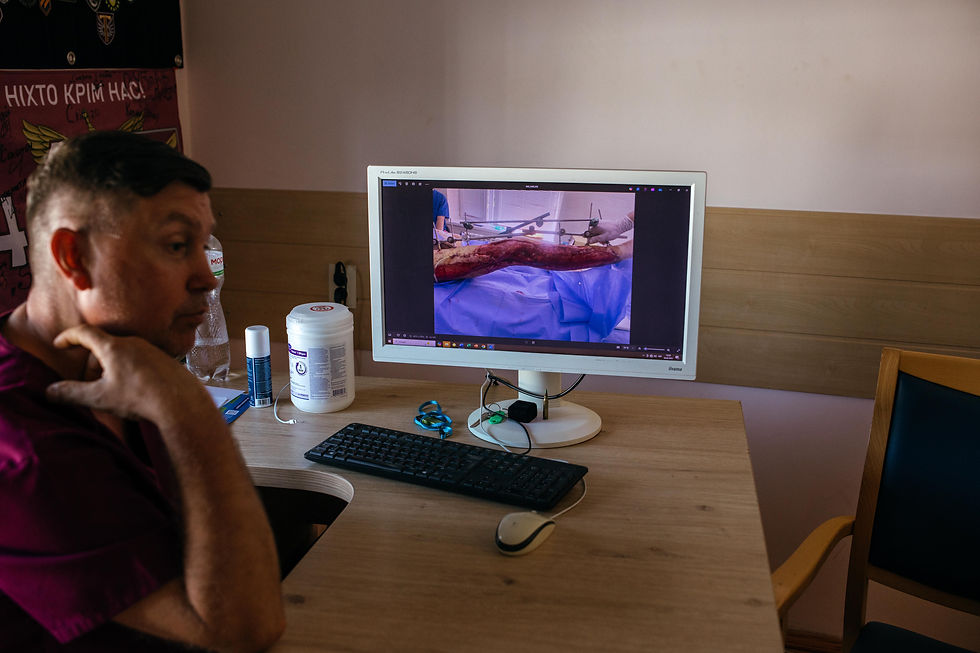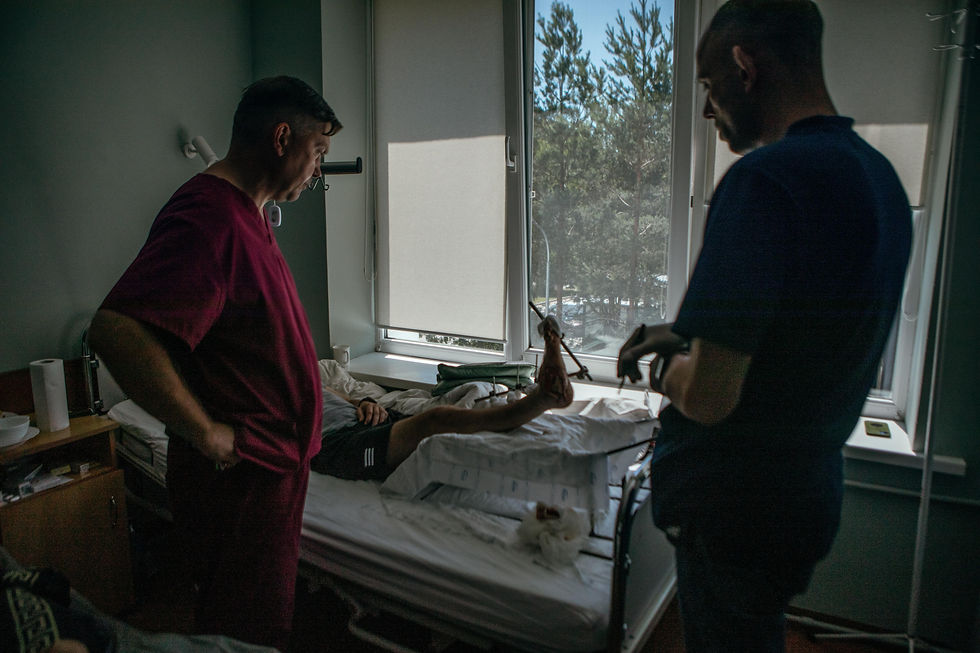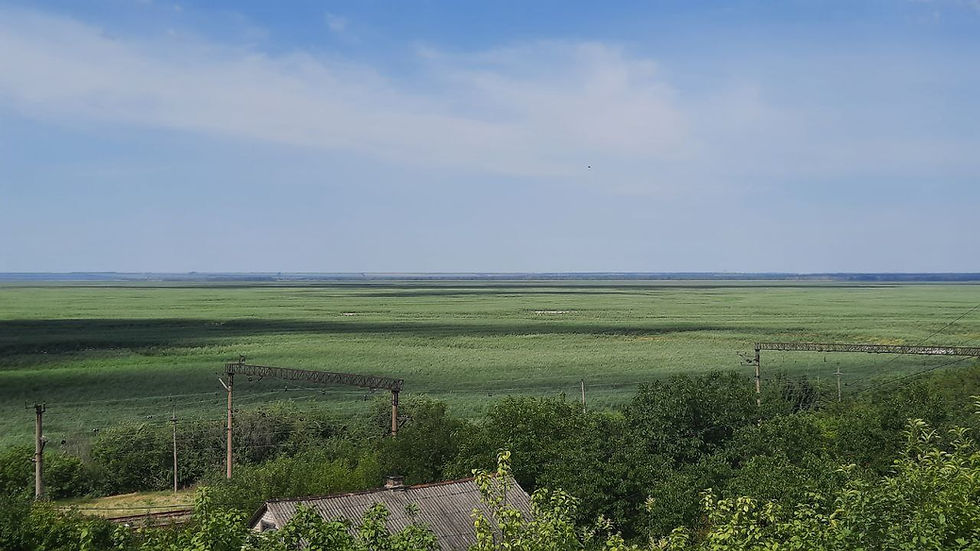Exclusive: Inside A Ukrainian Burn Unit
- Kang-Chun Cheng

- Aug 25
- 5 min read
Updated: Aug 28
WARNING: The images and content of this story may be disturbing to some audiences. Viewer discretion is advised.
Things are always urgent in Lviv’s Burn Unit.
The department, specializing in treating soldiers and civilians alike suffering from life-threatening burns, comprises two floors, situated within Saint Luke’s Hospital of the First Medical Territorial Union in an undisclosed location in Lviv, western Ukraine — more than a thousand kilometers from the frontlines. Although air raids here are not nearly as frequent as they are in Kyiv or Kharkiv, civilian casualties are embedded in the current reality.
Since the full-scale invasion on February 24, 2022, when Russia launched dozens of missile strikes across Ukraine, Lviv has become not only a haven for civilians fleeing their homes — artists in particular — but also a hub for those seeking specialized medical care.

As dire crises concurrently implode, from Israel’s ethnic cleansing of Palestinians in Gaza to the world’s biggest humanitarian crisis as military generals vie for control over Sudan, it’s impossible to keep Ukraine on the radar at all times. Ukrainians know this all too well; many whom I met during my time reporting there describe a dystopian combination of adapting to a new sense of normalcy without relinquishing the national resistance to Russian erasure of Ukrainian identity.

45-year-old Ivan Ryk, surgeon and the head of Lviv’s Burn Unit, meets us in his office after operating on a soldier with “big defects.” The soldier had stepped on a landmine somewhere on the frontline; major burns now cover 80% of his body, nearly disintegrating his knee joints. Ryk flicks through images of the casualty on his desktop, which we look through together.

“We have the principle of saving limbs whenever possible,” the doctor explains. “An amputation is simple — it takes only 15-20 minutes. But we’re thinking of the rehabilitation process, the patient’s quality of life later on.” I ask about this patient in particular. His prognosis actually isn’t bad, Ryk explains. They managed to circumvent amputation for the time being. “Later on, if the patient decides to have an amputation, we can always do that.”
For skin grafts, they try to use the patient’s own skin in cases of early trauma, but also utilize a combination of pig and fish skin sourced by various charities, along with grafts from donors.

It’s not only about soft tissue damage, but the holistic processes and consequences of healing. “Sometimes the patient can develop alopecia,” Ryk explains, which requires a separate emotional reckoning of its own. “Reconstructive and plastic surgery can help with overcoming both physical and mental aspects, doubling the effects of recovery.”
Although this Burn Unit in Lviv is among the most advanced in the nation, resources are stretched thin considering the protracted nature of the war and precarious geopolitical dynamics. The department relies on a combination of private donors, non-profit organizations (such as Ukraine is Europe, which helps source medical equipment and medicine), and governmental support to sustain its work; however, the Center for Global Development estimates that at $1.4 billion, Ukraine is by far the country most hard hit by the Trump administration’s cuts to USAID programs.
Ryk has worked at the Burn Unit for 24 years; the pace of the work inevitably spiked with the full-scale invasion. The team consists of seven doctors, handling 10-15 patients at any given time. Ryk estimates that he performs five to six operations a day and changes dressings for 8-12 other patients. During our visit, seven of the 43 patients who were seeking treatment were civilians injured in the war.

It’s a very fast-paced job, Ryk says. “We’re all equal here. It’s important that we all appreciate each other and work together toward victory.” He continues: “There’s an understanding that we are all in this together and cannot take a break. These are the circumstances we have been put in, so we have to live with that.”
There’s a corkboard by his desk, where he has collected badges from soldiers who recovered from critical injuries. “There are many, many more than what is shown here,” he says. “There isn’t space in this room for all of [the badges].

In one of the wards, we encountered a 22-year-old soldier mummified with bandages, fourth-degree burns covering 80% of his body. Many of the patients we’d gotten a glimpse of were dozing off when we peeked in; a few waved or gave a nod of recognition. Most spend about a month at the Burn Unit before they are sent home or elsewhere for further rehabilitation.

That evening, I called my aunt, a nurse practitioner at the Dana-Farber Cancer Institute who works mainly with leukemia patients. I had seen a lot over my two weeks in Ukraine, and figured that talking about the intense things I’d seen would be a good start for my own processing. “Burn trauma is one of the worst things one may experience,” she tells me.
Although the severity of patients’ injuries cannot be underestimated, their chances of making it are actually decent if they are at the Burn Unit. It can take up to two weeks before soldiers are transported from the frontlines to an intermediary medical tent en route to a Burn Unit.
The department in Lviv can support up to 60 patients. “Things are crazy here,” Ryk admits. “I work, I work, and I go home and sleep.”
“I’ve had colleagues who visit from abroad who say to me, ‘you must be used to this,’” he continues, shaking his head. “But it’s impossible to get used to [such traumatic injuries.]”

With heightened need from the full-scale invasion, the Burn Unit has welcomed collaborators from the Czech Republic, the United Kingdom, the U.S., Germany, and other countries to help care for the incessant stream of patients. “We very much appreciate when there are volunteers,” Ryk says. “Those who understand the specifics of this work.”
As he prepares for yet another operation, Ryk muses on how the intensity of his work has affected his sense of what can be considered normal. “I like to be on a bus or tram and just watch people as they are, dealing with their normal problems, not needing anything from me,” he tells me. It’s a critical break from interacting with patients who are fighting for their lives.
“I love fishing, barbecues, playing football,” the doctor recounts, as if from a past dream. “But now, if I have a moment of peace, I feel like I don’t know what to do.”

This story was supported by the International Women's Media Foundation’s Women on the Ground: Reporting from Ukraine’s Unseen Frontlines program in partnership with the Howard G. Buffett Foundation. Marta Sloboda also contributed reporting.










